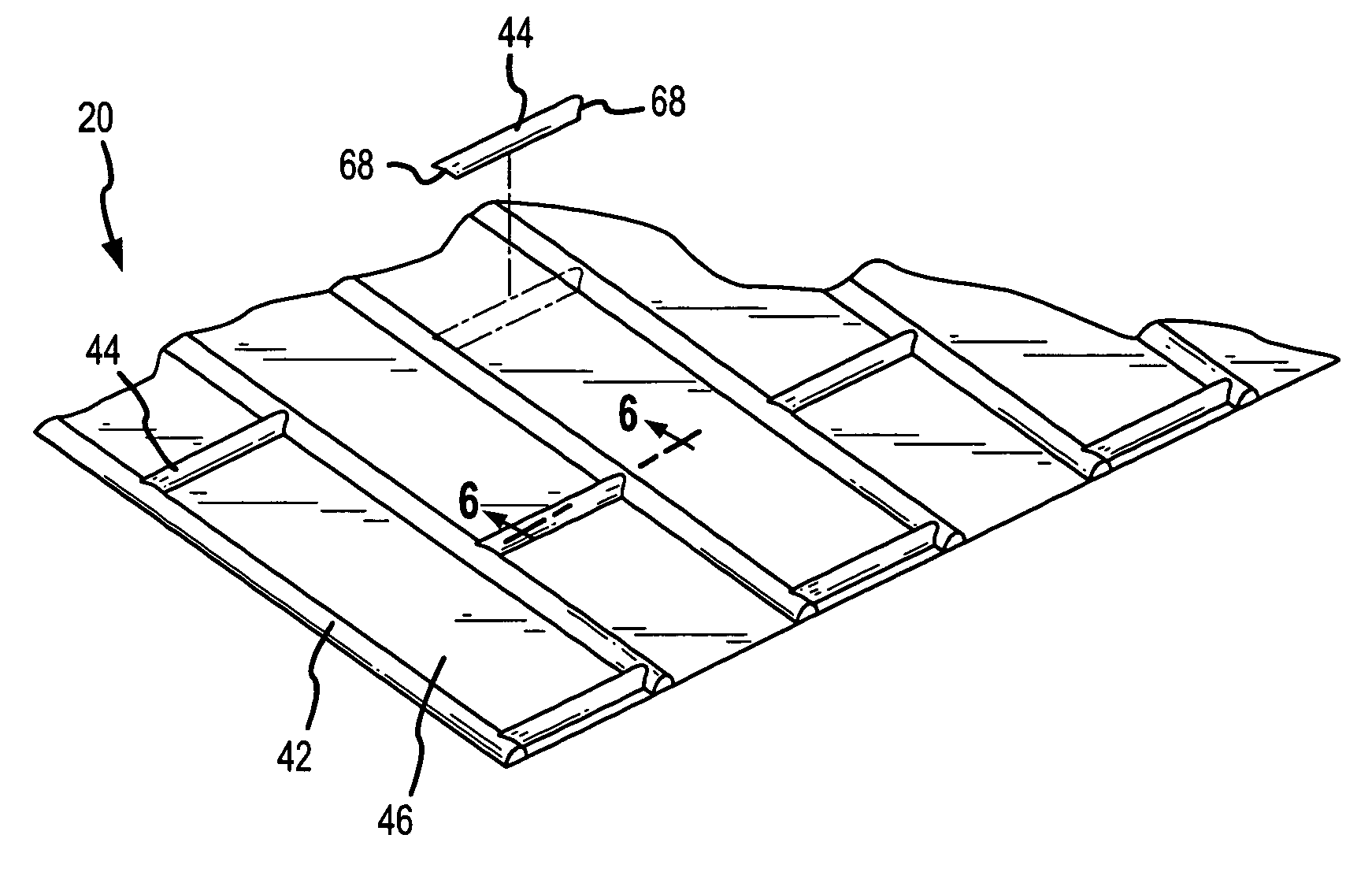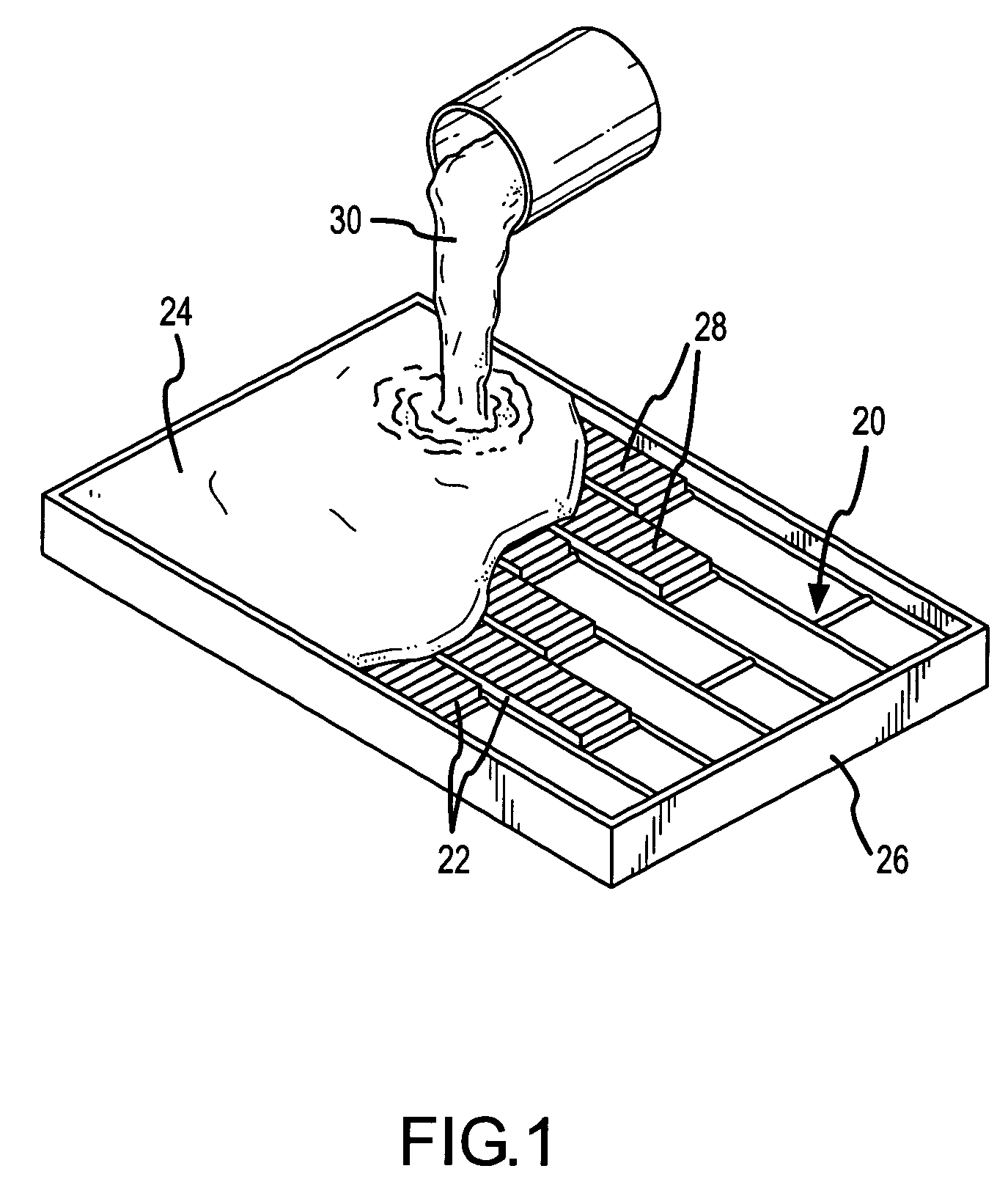However, both of these types of liners suffer from problems that add to the cost and time required to form embedded brick walls with these prior art liners.
The size of these prior art brick liner panels is necessarily limited due to manufacturing and handling constraints (i.e., each panel holds approximately 40 bricks).
However,
cutting and aligning a large number of hard plastic liner panels to fit within a form is time-consuming work.
Furthermore, due to the inherent thickness of each plastic liner panel, the regions within the form where two or more panels overlap are necessarily raised above the remainder of the liners within the form so that the embedded bricks (or other objects) along these overlapping regions may appear to be misaligned or slightly recessed within the finished wall.
A further difficulty encountered with the prior plastic liner panels relates to the rigid nature of the panel material and particularly the curved joints between the recessed brick-receiving regions.
Unfortunately, such leakage is bound to occur since even custom-ground brick pavers will include some tolerance or margin of error in their outer dimensions.
While brick pavers that are
cut too small will leave a gap between the brick and at least one
joint line that allows the poured-
wall material to seep past the joint and contact the face of the brick paver, problems also arise when brick pavers are
cut too large to fit cleanly within the brick-receiving region.
Specifically, because the hard plastic joint lines are not malleable, the joints cannot adjust to accommodate oversized bricks.
Thus, even a slightly oversized brick paver (i.e., ⅛ inch or more out of specification in either the length or the height dimension) will not be seated correctly within the liner, thereby allowing the poured-
wall material to leak around to the front of the brick paver.
Additionally, oversized bricks that do not fit properly within the liner will be misaligned (i.e., will not appear flush) with the other bricks, possibly causing unacceptable
visual defects in the finished wall.
However, in certain climates (such as Florida or Arizona), the temperatures in the mold may rise close to or even exceed the
melting point of the
wax, thus causing the
wax coating to soften and wick into the brick or simply evaporate.
A further drawback to the use of a
wax coating relates to the added cost to have each brick coated with wax.
Indeed, the combined extra cost of first
grinding the brick pavers to the exacting dimensions required for use within the hard plastic liner, and then applying a wax
coating to the faces of the brick pavers, nearly doubles the price of a standard brick paver.
Thus, prior art plastic brick liners suffer from a number of drawbacks mainly centering around the rigid nature of the plastic joints used to define the brick-receiving regions within the liner.
Since it is not possible to form an airtight seal between the brick paver and the plastic joint lines (even when using ground bricks), concrete leakage onto the front faces of the brick pavers will be a constant problem necessitating the use of
specialty wax-coated bricks to ease the process of cleaning the concrete off of the finished brick faces.
Additionally, the plastic liner panels are not thermally stable, and thus the same high temperatures that can create difficulties with the wax coating may also cause the liner material itself to expand and create even larger gaps between the joints and the brick pavers.
Lastly, workers using rigid plastic liner panels are not able to adjust the size or location of the vertical head joints to accommodate wall forms that are not sized to precisely fit the dimensions of the plastic liner panels (or to accommodate changes in the size of the panels due to temperature changes).
Unfortunately, due to measurement errors and the above-described
thermal instability of the plastic liners, it is common that the one-half running bond brick pattern will not fit precisely within the wall form, thereby necessitating the
grinding of custom-sized bricks (e.g, ⅜ and ⅞ bricks) to complete the pattern at one end of the wall.
While a mason forming a fully laid-up brick wall can address such issues by adjusting (i.e., increasing or decreasing) the width of the vertical head joints near the end of the wall to ensure a proper fit, no such adjustments are possible with the fixed vertical head joints in the plastic liner panels.
While prior art foam liners address some of the above-described problems attributed to the hard plastic liner panels, such foam liners were not without their own problems.
A second problem associated with the foam liner shown in the '180 patent relates to the act of
cutting or routing the foam material to form the desired
grid pattern as shown in FIGS. 2 and 3 of the '180 patent.
Indeed, in the sole commercial implementation of the preferred embodiment shown in FIGS. 2-6 of the '180 patent, a significant amount of time was required to manually scrape the remnants of the foam joints from the
grout lines of the finished wall.
Finally, while the malleable nature of the foam liner disclosed in the '180 patent helps to form a relatively snug seal with the brick pavers (thereby reducing the amount of leakage and accumulation of concrete on the faces of the bricks), the fully integrated nature of the foam grid (as shown in FIGS. 8 and 9 of the '180 patent) does not allow for large tolerances in the size of the brick pavers used to fill the foam liner.
This integral construction limits the relative movement of the adjoining head joints and bed joints so that it is difficult to squeeze a slightly oversized brick into one of the brick-receiving regions of the foam liner shown in '180 patent (i.e., the brick tends to bind at the corners where the head joint meets the bed joints and the foam material tends to push the brick back out of the pocket causing a noticeable misalignment in the finished wall).
 Login to View More
Login to View More 


